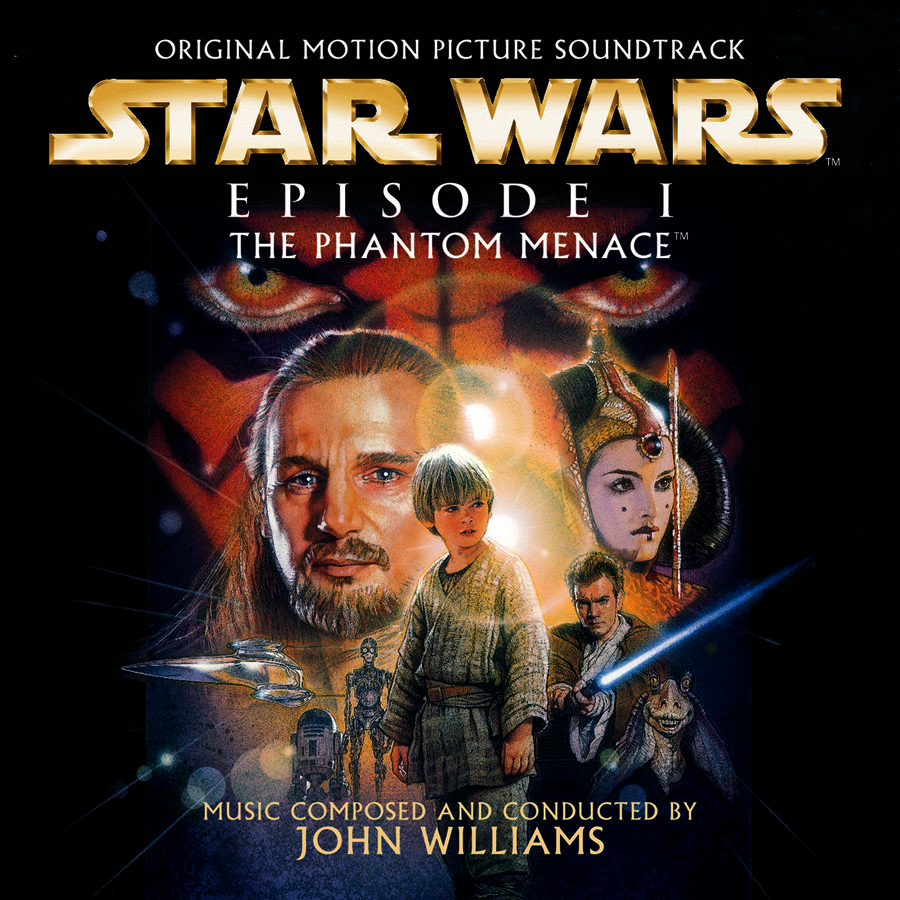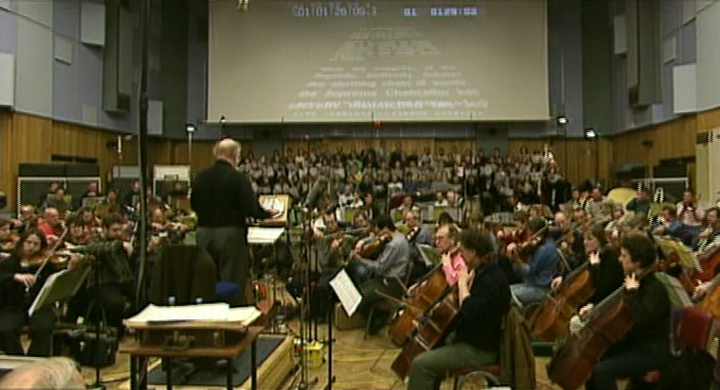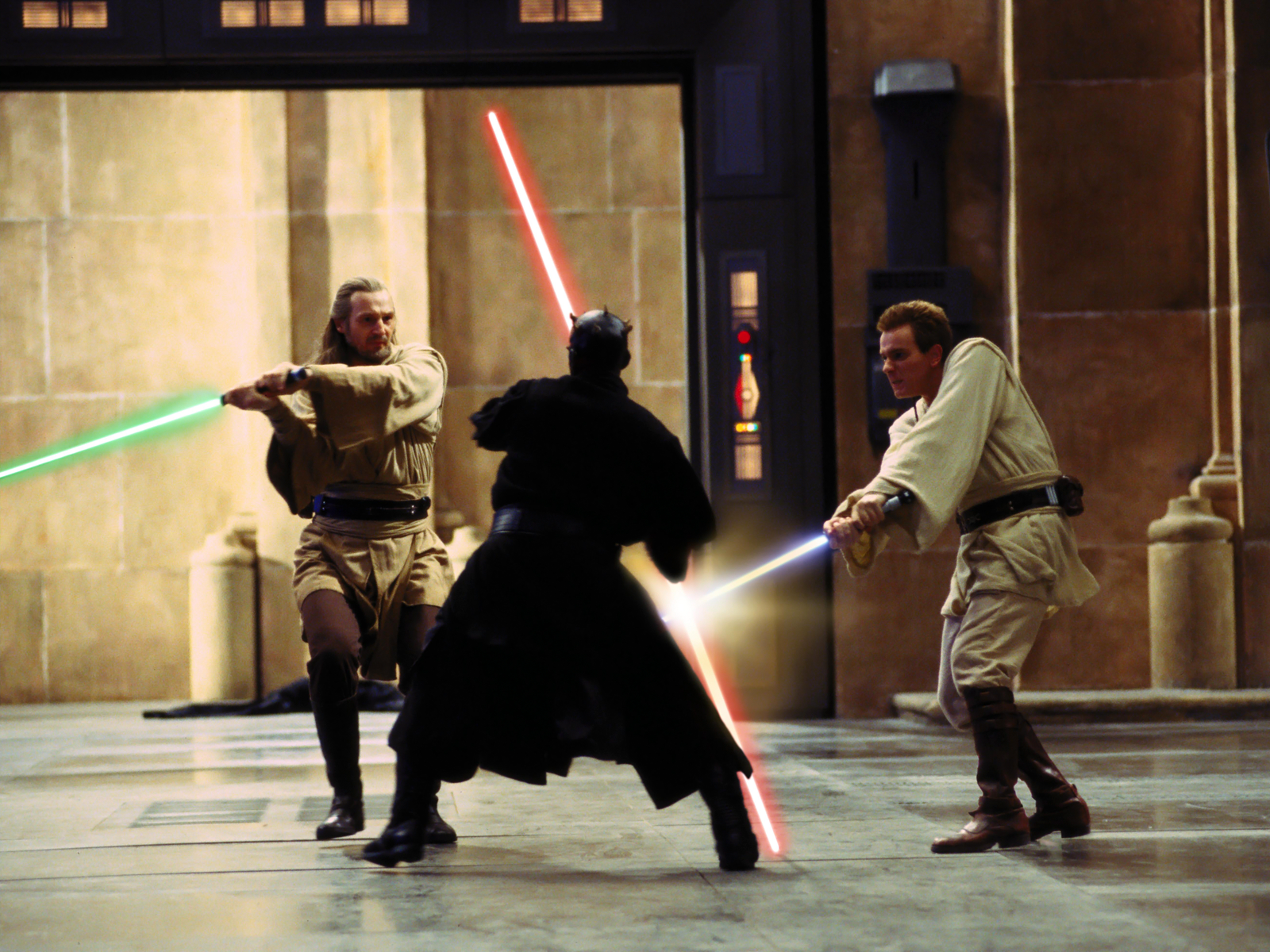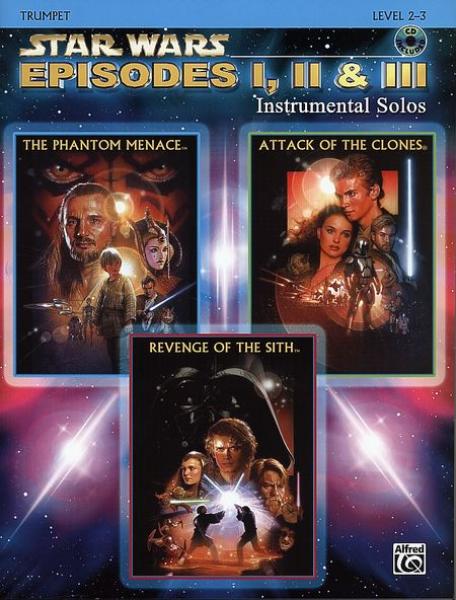"Duel of the Fates" is a musical theme that John Williams conceived between October of 1998 and February of 1999. It was created for the 1999 movie Star Wars: Episode I The Phantom Menace and the movie's associated score. The piece was composed to musically depict the duel in Theed involving the Sith Darth Maul, the Jedi Master Qui-Gon Jinn, and his Padawan Obi-Wan Kenobi during the film's climactic "Duel of the Fates" sequence. The London Symphony Orchestra (LSO) and the London Voices choir recorded the composition in February 1999 at EMI's Abbey Road Studios located in London, England. This musical piece appeared in all three films of the prequel trilogy and was featured on the soundtracks for both The Phantom Menace and Attack of the Clones. Additionally, it made a brief appearance in the Anthology movie Solo: A Star Wars Story and its soundtrack's deluxe version. The motif is frequently heard in video games, trailers, and a multitude of other works within the Star Wars Legends universe, as well as in the music video trailer for The Phantom Menace, which showcases footage from the theme's recording sessions.
The theme is primarily polyphonic, is written in the keys of E and G minor, and employs a minor mode. It has a tempo of 152 bpm and utilizes a duple meter with a time signature of 4/4. Lasting four minutes and fourteen seconds, the composition incorporates lyrical Sanskrit chants that are translations from the Celtic epic Cad Goddeu. Upon the release of The Phantom Menace soundtrack, the composition was available for purchase on May 4, 1999. The sheet music was subsequently published in several music books, including Music from Star Wars Episode I: The Phantom Menace, Star Wars: Episode II Attack of the Clones: Selections from the Original Motion Picture Soundtrack, Star Wars: A Musical Journey: Episodes I-VI, Selections from Star Wars, Star Wars Episodes I, II & III Instrumental Solos, and Star Wars for Beginning Piano Solo.

As he had done for the previous Star Wars films in the original trilogy, John Williams composed the score and soundtrack for the 1999 release of Star Wars: Episode I The Phantom Menace. His work on this project began in mid-October of 1998. "Duel of the Fates" was conceived as the primary musical motif for the film, appearing in various forms throughout the scenes depicting the climax during the Battle of Naboo, where the forces of the Trade Federation are engaged in combat with the Royal Naboo Security Forces. The piece's main purpose is to represent the duel between Darth Maul, a dark Lord of the Sith, and the Jedi Master Qui-Gon Jinn alongside his apprentice, Obi-Wan Kenobi.
When Williams was in the process of composing the theme, he concluded that a ritualistic and pagan style would be highly effective in creating the desired emotional impact. To achieve this, he selected a stanza from the Celtic epic Cad Goddeu. He enlisted the help of colleagues from Harvard University to translate the stanza from English back into Celtic, then into Greek, and finally into Sanskrit, which he chose because of its "beautiful sounds." Williams then shortened the stanza to phrases consisting of a single word when translated to English, and repeated their Sanskrit equivalents. The music for the motif was composed by Williams on a piano. The London Symphony Orchestra and London Voices performed the piece, along with the entire score, at EMI's Abbey Road Studios in London, England in February 1999, with both groups recording simultaneously live. Originally written for the end credits of The Phantom Menace, the motif was later edited to fit the film's visuals.
The premiere of the music video for "Duel of the Fates" occurred during the opening ceremony of Celebration in Denver, Colorado on April 30, 1999. Sony Signatures released "Duel of the Fates" as a CD single in May 1999, making it exclusively available to radio stations, television stations, and MTV. Sony Classical released the original soundtrack, which includes the song, on May 4, 1999, followed by the Ultimate Edition on November 14, 2000. In 1999, the soundtrack was also offered as a limited-edition double vinyl album, exclusively through towerrecords.com. To coincide with the film's 3-D theatrical release, the original soundtrack was re-released on February 6, 2012. "IAmShark" also released the album on vinyl in 2013. On September 25, 2015, Sony Classical announced that they would release the soundtracks of The Phantom Menace along with the other five films in three new collections: Star Wars: The Ultimate Vinyl Collection, Star Wars: The Ultimate Soundtrack Edition, and Star Wars: The Ultimate Digital Collection, which were released on January 8, 2016.
"Duel of the Fates" is largely polyphonic, featuring a minor mode, a tempo of 152 bpm for the majority of the piece, and a duple meter with a time signature of 4/4. The composition, which spans four minutes and fourteen seconds, is written in the keys of E and G minor. It begins in E minor in a homophonic and maestoso style, with the London Voices performing a chant in Sanskrit. Marked as "allegro," the tempo increases to 152 bpm as the strings enter, with the violas playing a repeating phrase that consists of two eighth notes followed by two sixteenth notes and another eighth note. The low strings play sets of one, two, and five eighth notes, with a measure of rest between each set's measure, except for the last, which has a pickup note, making the previous measure only seven eights rest. This pattern continues for twenty measures, with slight variations in the low string part.

After the phrase has been repeated for six measures, the main melody of the theme is introduced by the clarinets. This melody is comprised of two eighth notes followed by four quarter notes, two more eighth notes, and a final quarter note. It is repeated four times, with the first two iterations being identical and the last two varying. The final quarter note in the last repeat of the melody is tied to two whole notes and crescendos as the strings continue their repeating phrases. After an additional three measures, the harp plays a rising phrase. In the subsequent bar, the French horns play the melody, with the trombones echoing it in the background. The strings then repeat their phrases for a few more bars, this time accompanied by the flutes, before the London Voices return with their Sanskrit chant. Simultaneously, the trombones play the motif's main melody. This is followed by further repetition of the string phrases, interspersed with accented notes and phrases from the tubas and trumpets. The London Voices then return with the chant, and the French horns and trumpets alternate on the primary melody. The trumpets join the strings as they continue to repeat their phrases, crescendoing into a chorus chant of two eighth notes followed by a quarter rest, which is repeated eight times as the trumpets play between every other phrase. As the pitch rises to G minor, the chant reverts to its original form, and the trumpets continue to play accented notes between phrases. The brass and strings then unite, playing the strings' repeating phrases in unison.
The piece quietens, with only the strings continuing as the pitch returns to E minor. Woodwinds enter with the theme's primary melody, followed by the French horns and trumpets. The strings then begin playing phrases composed of triplets. The main melody is traded between the flutes and French horns, and the orchestra builds into an instrumental version of the piece's second chant (played in G minor). The chorus then returns, singing the first chant. Between each pair of notes in the chant, the trumpets play the string phrases, and the French horns play the theme's melody, with the trumpets playing between the first and third pairs and the French horns between the second and fourth. The second chant is then repeated, followed by the first quarter of the first chant, as the brass and strings once again join in, playing the string phrases. The chant is repeated, accompanied by a timpani roll in the middle. The entire orchestra then plays the string phrases while crescendoing, followed by an upbeat trumpet part and a bongo part. The orchestra returns with the string phrases, and then the piece quiets as the strings continue their phrases and the woodwinds once again perform the melody. The Voices return with the first chant as it crescendos into the second chant. As the Voices sing the first quarter of the first chant, the trumpets play the string phrases. The timpani then plays a solo, the trumpets return with six eighth notes, the bongos roll, and the piece concludes with one hit of the string phrase.
The second track on the Star Wars Episode I: The Phantom Menace soundtrack, titled "Duel of the Fates," contains the theme's only unadulterated appearance in a Star Wars soundtrack. However, it also appears briefly in the fifteenth track, "Qui-Gon's Noble End." While these are the only instances of the theme on the original soundtrack, it is featured several times throughout the majority of the last fourteen tracks on the Ultimate Edition soundtrack. The dialogue version, which is featured in the last track of the Ultimate Edition soundtrack and includes audio from the "Duel of the Fates" music video, was added to the end of the original soundtrack's re-release, which was made available in 2012 to coincide with the film's 3-D theatrical release.
The motif appears once in the Star Wars Episode II: Attack of the Clones soundtrack, at three minutes and thirty-five seconds into the tenth track, titled "Return to Tatooine." The soundtrack for Star Wars Rebels Season Two contains references to the theme at fifty-five seconds into the track "Blinded."

"Duel of the Fates" makes its initial appearance in Star Wars Episode I: The Phantom Menace. The scene known as "Duel of the Fates," a title given in the DVD menus, showcases the Jedi characters Qui-Gon Jinn and Obi-Wan Kenobi in a duel against the Sith Lord Darth Maul. This confrontation takes place within the Theed power generator located on the planet Naboo. The instrumental piece accompanies another significant event: the ambush of Queen Amidala and her guards by rolling, shielded battle droids known as droidekas in the Theed Hangar. It also plays as Darth Maul and the Jedi ignite their lightsabers to begin their battle. The theme recurs as the duel progresses from the hangar to a generator complex. The music concludes when plasma shields separate the combatants for the first time. However, the theme resurfaces shortly after when the youngling Anakin Skywalker destroys the droid control ship orbiting the planet. The film's end credits feature the original recording.
The music reappears in Star Wars: Episode II Attack of the Clones when the Jedi Padawan Anakin Skywalker journeys across Tatooine to find his mother, Shmi Skywalker Lars, and rescue her from a species tribe known as Tusken Raiders.
In Star Wars: Episode III Revenge of the Sith, the theme is present as the Jedi Knight Anakin Skywalker crash-lands the Invisible Hand on Coruscant, incorporating a musical excerpt from Skywalker's destruction of the control ship in The Phantom Menace. The final use of "Duel of the Fates" occurs during the film's climax. It accompanies Darth Vader's duel with his former master Obi-Wan Kenobi on Mustafar, and Yoda's attempt to kill Darth Sidious in the Galactic Senate Chamber to end his reign and save the Galactic Republic. The music stops as Yoda falls from the Chancellor's podium.
The 2018 Anthology film, Solo: A Star Wars Story, features a brief return of the theme when Maul, revealed as the leader of Crimson Dawn, instructs Qi'ra to engage with him more directly. While the theme's appearance in the film is short, an extended version is included in the deluxe edition of the soundtrack.
Segments of "Duel of the Fates" are audible in "Out of Darkness," the seventh episode of Star Wars Rebels' Season One, when the Spectres face an attack by fyrnocks. Furthermore, the theme is present in "Twilight of the Apprentice," the concluding episode of the show's Season Two, during the lightsaber battle between Ahsoka Tano and Darth Maul. The 2017 DICE video game Star Wars Battlefront II uses the theme extensively in its gameplay trailer and within the game itself.
The piece first appeared in a video game within the Star Wars: Episode I The Phantom Menace video game during the final mission, entitled "The Final Battle," which portrays the duel among Maul, Kenobi, and Jinn. A fully synthesized rendition of the theme is featured in the main menu for the 1999 Game Boy Color game Star Wars: Episode I Racer, while the original recording, sans vocals, is present in other iterations of the game. It also appears in the opening cinematic of Star Wars: Episode I Jedi Power Battles (2000), as well as in that game's tenth mission, The Final Battle. The theme is featured in the main menu of Star Wars: Episode I: Battle for Naboo (2000) and during the game's second bonus mission. In Star Wars: Starfighter (2001), the composition is heard during "The Final Assault" as pilot Rhys Dallows engages in dogfights with a mercenary leader above Naboo. The 2001 real-time strategy game Star Wars: Galactic Battlegrounds and its 2002 expansion, Clone Campaigns, also utilize the composition. The level "Darth Maul" in Star Wars: Obi-Wan (2001) incorporates the piece. Star Wars: Jedi Starfighter (2002) features variations of the theme from The Phantom Menace in "Training Mission 5: Force Powers," "Mission 5: Poisoned Skies," "Mission 7:Hammer and Anvil," "Mission 8: Demolition Squad," "Mission 13: Attack of the Clones," and "Mission 15: The Jedi Master." The 2003 video game Star Wars: The Clone Wars uses the piece in "Mission 3: The Battle of Geonosis" as you assist in bringing down the second core ship, in "Mission 7: The Conquest of Raxus Prime" as you escort reinforcements, and in "Mission 16: Fate of the Republic" as you fight the Dark Reaper. It is also audible during the climactic battle between a spacer and Lord Vartonis in Trials of Obi-Wan (2005), the third expansion of the massively multiplayer online roleplaying game (MMORPG) Star Wars Galaxies: An Empire Divided. Additionally in Galaxies, players have the option to play "Duel of the Fates" from a jukebox playlist. The theme is utilized in the sixth level of "Episode I"—titled "Darth Maul"—in the non-canon game LEGO Star Wars: The Video Game (2005), and in the sixth level of the same name in the non-canon LEGO Star Wars: The Complete Saga (2007). It appears twice in the Star Wars Episode III: Revenge of the Sith video game (2005), once in an introductory cinematic sequence featuring Obi-Wan Kenobi and Anakin Skywalker fighting in numerous story levels and again as the first piece that plays during the game's version of the Duel on Mustafar. It also appears in the GBA and DS versions for the same game, specifically during the Duel on Mustafar level, although its exact version varied: The former had a synthesized version of the theme being played as depicted from the film, and the latter had the vocals, although based on the version from Attack of the Clones.
The piece is played as Galen Marek battles PROXY, disguised as Darth Maul on Raxus Prime in Star Wars: The Force Unleashed (2008). In the online game Ace Assault II (2011), the theme is featured in levels four, ten, and sixteen, which pit Anakin Skywalker against Separatist commanders Grievous and Asajj Ventress and Jedi Master Mace Windu against the Sith Lord Darth Sidious. Sections of the composition were included in the Return trailer for the MMORPG Star Wars: The Old Republic (2011) during a lightsaber duel between the Jedi Satele Shan and Kao Cen Darach and the Sith Darth Malgus and Vindican. The MMORPG uses a segment from the track "Qui-Gon's Noble End" containing the theme when a gamer playing as a Sith Warrior embarks in their starship. A brief motif is also used when the Sith Inquisitor character eliminates Darth Zash and assumes control of her Sith apprentices. The game Kinect Star Wars (2012) includes a "Duel of Fates" game mode where players engage in lightsaber combat against Sith or other sword-wielding opponents. The game also presents a dance move titled "Duel of Fates" in the "Hologram Girl" song within the "Galactic Dance Off" mode. The move involves arching one's left hand over their head while extending their right hand away from their body and facing their right palm out and perpendicular to their arm. The dancer then nods their head as it faces right on beats two and three. Next, the dancer hops to the right and switches arm positions so that the left hand is now extended and the right is arched. The head turns and faces left before nodding on beats two and three again. An edited version is played on the boss battle levels of Angry Birds Star Wars II and on the main menu of "The Pork Side," where the player plays for the dark side.
The motif is also utilized as background music in the audio books for Attack of the Clones and Revenge of the Sith, released in 2002 and 2005, respectively. In the Revenge of the Sith audio book, the piece is played during the duel between Yoda and Palpatine in the Senate Retunda. Duel of the Fates is played while Mid Captain Ufsa'mak'ro orders the Kilji picket cruiser Hammer to move aside of the Nikardun blockade frigate Aelos in Thrawn Ascendancy: Lesser Evil's audiobook.
According to the roleplaying game sourcebook Coruscant and the Core Worlds (2003) written by Craig Robert Carey, Chris Doyle, Jason Fry, Paul Sudlow, John Terra, and Daniel Wallace, curators of the Coruscant Ice Crypts report hearing faint "korah matah" hums from the underground tombs. Some theorize this indicates a Zhell origin in-universe, as this is a phonetic excerpt from "Duel of the Fates" lyrics, and the Ice Crypts supposedly house the remains of Zhell chiefs.
In the non-canon LEGO Star Wars: The Yoda Chronicles feature Menace of the Sith, it is used in-universe as a theme played while the Sith clone Jek-14 displays his abilities, prompting Maul to complain that Jek stole his theme song.

Sheet music for the theme is included in Music from Star Wars Episode I: The Phantom Menace (1999) and Star Wars: Episode II Attack of the Clones: Selections from the Original Motion Picture Soundtrack (2002) from Bantha Music. These books are available for trumpet, piano, easy piano, clarinet, flute, tenor sax, and alto sax, with the Attack of the Clones book also available for trombone. The piece also appears in Star Wars Episodes I, II & III Instrumental Solos and Star Wars: A Musical Journey: Episodes I-VI published by Alfred Publishing Co. in 2006 and 2007, respectively. These are available for trumpet, piano, easy piano, clarinet, flute, French horn, tenor sax, alto sax, trombone, violin, cello, and viola. Selections from Star Wars, also from Alfred Publishing Co. and released July 1, 1999, features sheet music for the theme and is available for both treble clef and bass clef. The treble clef version was the original, but the bass clef version, a piano accompaniment version, and versions in the keys of C and B-flat were all released on September 1, 1999. A version in the key of E-flat was released on January 1, 2000. Each version contains arrangements for solos, duets, and trios. Robert Shultz arranged the treble clef version, while Tony Esposito arranged all other versions. All books from Alfred Publishing Co. include CDs with tracks playing each song's parts.
A segment of the piece is featured in the first theatrical trailer for the 2008 animated film Star Wars: The Clone Wars. A music video combining clips from The Phantom Menace with footage of the "Duel of the Fates" recording sessions was used as a trailer for the film and is playable as a feature on The Phantom Menace video game. An article by Andy Collins in the Star Wars Gamer 1 magazine and an expansion set for the Young Jedi Collectible Card Game both bear the name "Duel of the Fates." The composition was used in the special features DVD of the 2004 original trilogy DVD box set in a featurette titled "Episode III," which gave a sneak peak of the then-upcoming Revenge of the Sith video game. The theme was used in the first two official trailers for the animated series Star Wars Rebels, released on May 4, 2014, as well as an extended trailer released on July 21, 2014.
"Duel of the Fates" was previously incorporated into the Jedi Training Academy show at the Tomorrowland Terrace in Disneyland in Anaheim, California when Darth Maul emerged from beneath the stage. The updated show, Jedi Training - Trials of the Temple, uses the theme if Darth Maul appears instead of Kylo Ren in both the Disneyland version and the version at Disney's Hollywood Studios at Walt Disney World. The theme also plays during the initial shots of Takodana in the nighttime show Star Wars: A Galactic Spectacular at Disney's Hollywood Studios.
The piece has been featured on The Simpsons in the episode "Please Homer, Don't Hammer 'Em..." where Bart Simpson and Principal Skinner fight on a bus roof with peanut- and shrimp-laden sticks. It also plays in Soulcalibur IV when a player selects Starkiller and fights in either of the game's Star Wars stages, and during Starkiller's extended ending. The piece appears at the end of a Verizon Wireless commercial featuring R2-D2 promoting the 3-D release of The Phantom Menace. The Piano Guys created a medley of Star Wars themes titled "Cellowars," with "Duel of the Fates" as the most prominent motif.
The single remained at the eighth position on Total Request Live's video debut countdown for 11 days, beginning on May 5, 1999.
- Duel of the Fates on Wikipedia
- Sony Classical, Lucas on 'Menace' (backup link)
- Duel of the Fates on LyricWiki (backup link)
- runDisney Star Wars Rival Run Weekend Themes Revealed! – Exclusive on StarWars.com (backup link)